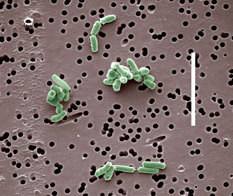| |

Photo
courtesy of Jeff Broadbent,
Utah State University
|
The Brevibacterium
genus is a heterogeneous mixture of coryneform organisms that have particular
application to industrial production of vitamins, amino acids for fine chemical
production, and are commonly used in cheese production (Amador et al., 1999;
Rattray and Fox, 1999). This genus contains 9 species from diverse habitats,
such as soil, poultry, fish, human skin, and food. While Brevibacterium
linens is phenotypically similar to Arthrobacter globiformis cellular
pigmentation, cell wall composition, DNA/DNA hybridization and 5s RNA analysis
show that Brevibacterium is distinctly different (Park et al., 1987).
PFGE analysis indicates that diversity within the species is related to
polymorphisms in the 16S rRNA genes with genome sizes that range from 3.2
and 3.9 Mbp (Lima and Correia, 2000).
B. linens
is a non-motile, non-spore forming, non-acid fast, Gram-positive coryneform
that tolerates high salt concentrations (8-20%) and is capable of growing
in a broad pH range (5.5-9.5), with an optimum of pH 7.0. They are also
survive carbohydrate starvation and drying for extended periods (Boyaval
et al., 1985). B. linens is unusual as they produce base as they
grow, raising the pH to ~9.5 within 24-36 hours. Recent interest in B.
linens has focused around their ability to produce a self-processing extracellular
proteases (Rattray et al., 1995; Weimer et al., 2000), their ability to
produce high levels of volatile sulfur compounds (Ferchichi et al., 1985;
Dias and Weimer, 1998a, and 1998b), bacteriocin production (Valdes-Stauber
and Scherer, 1996), cell membrane associated carotenoid pigment production
(Arrach et al., 2001), and aromatic amino acid metabolism (Leuschner and
Hammes, 1998; Ummadi and Weimer, 2001).
These organisms are
also noted for their metabolize heterocyclic and polycyclic ring structures
– a trait that is not associated with other bacteria but is common
in fungi. Of particular note is the degradation of insecticides (including
DTT and DDE. These organisms also metabolize amino acids to produce plant
growth hormones (especially from aromatic amino acids).
References:
- Amador E, J.M.
Castro, A. Correia, and J.F. Martin. Microbiology. 1999. 145:915-24.
- Arrach N, R.
Fernandez-Martin, E. Cerda-Olmedo, and J. Avalo. 2001. Proc Natl Acad
Sci 98:1687-92
- Boyaval P, E.
Boyaval, M.J. Desmazeaud. 1985. Arch Microbiol 141:128-32.
- Dias, B. and
B. Weimer. Appl Environ Microbiol 1998a. 64:3320-6.
- Dias, B. and
B. Weimer. Appl Environ Microbiol 1998b. 64:3327-31.
- Ferchichi, M.,
D. Hemme, M. Nardi, and N. Pamboukdjian. 1985. J. Gen. Microbiol. 131:715.
- Leuschner R.G.,
W.P. Hammes. 1998. J Food Prot 61:874-8.
- Lima P.T., Correia
AM. 2000. Curr Microbiol 41:50-5.
- Park Y.H., H.
Hori, K. Suzuki , S. Osawa, K. Komagata. 1987. J Bacteriol 169:1801-6.
- Rattray F.P.
and P.F. Fox, A. Healy. 1997. Appl Environ Microbiol 63:2468-71.
- Rattray F.P.
and P.F. Fox. 1999. J Dairy Sci 82:891-909.
- Ummadi, M. and
B.C. Weimer. 2001. J Dairy Sci . 84:1773-82.
- Valdes-Stauber
N.and S. Scherer. 1996. Appl Environ Microbiol 62:1283-6.
- Weimer, B. C.,
X. Yi, and R. Brown. 2000. International Dairy Federation Biennial Cheese
Flavor Conference, Banff, Alberta.
|

